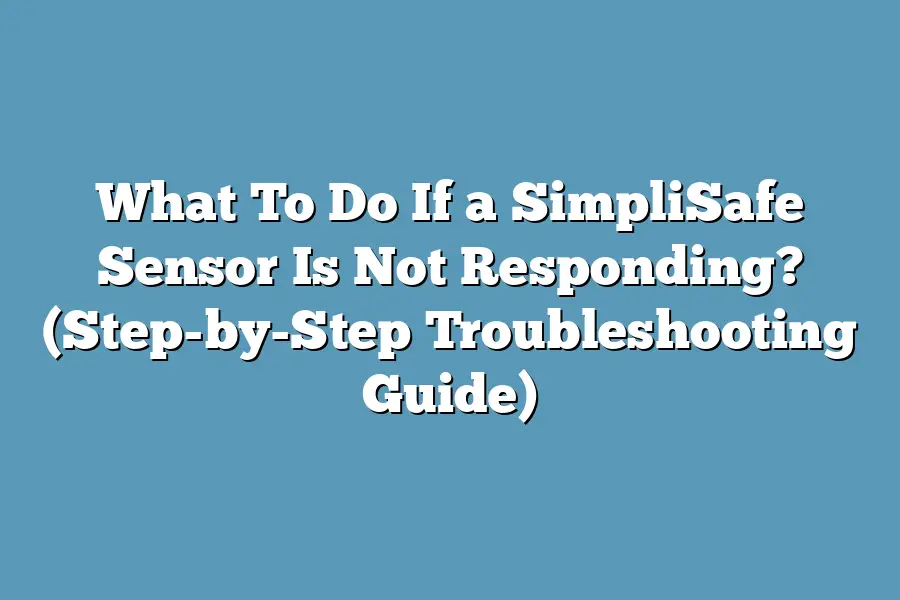Hey there!
If you’ve ever had a SimpliSafe sensor not responding, I’ve got your back.
In this guide, we’ll cover why responsive sensors are crucial and the step-by-step troubleshooting process.
From checking the battery to testing the sensor, you’ll be a troubleshooting pro by the end.
Let’s dive in!
Table of Contents
Here’s a Quick TLDR
If a SimpliSafe sensor is not responding, the first step is to check the battery.
Ensure that the battery is properly connected and replace it if necessary.
Next, try power cycling the sensor by removing the battery, waiting a few seconds, and then reinserting it.
If the issue persists, resetting the sensor by removing and re-adding it to the system may help.
If none of these steps resolve the problem, contacting SimpliSafe customer support for further assistance is recommended.
Understanding the Importance of a Responsive SimpliSafe Sensor
When it comes to home security, a responsive SimpliSafe sensor is the linchpin of your entire system.
These sensors are the frontline defense, detecting any intrusion or unusual activity in your home and alerting you to potential security threats.
So, it’s crucial that these sensors are always in optimal working condition to ensure the safety and security of your property and loved ones.
Why a Responsive Sensor Matters
A non-responsive SimpliSafe sensor can leave vulnerabilities in your home security system and compromise the protection it offers.
Without a functioning sensor, you may not be alerted to potential break-ins or emergencies, leaving your home and family at risk.
This highlights the critical role a responsive sensor plays in the effectiveness of your security setup.
Data and Statistics
According to a study by Home Security Heroes, 85% of successful break-ins occur through non-forced entry, making it essential to have fully operational security sensors to detect these subtle intrusions.
Without a responsive sensor, your system’s ability to detect and thwart potential threats is significantly reduced, putting your home and valuables in jeopardy.
The Impact on Peace of Mind
In addition to the physical security aspect, having a non-responsive sensor can also impact your peace of mind.
Knowing that your security system is not fully functional can create unnecessary stress and worry.
After all, the whole purpose of a security system is to provide peace of mind, and a malfunctioning sensor can negate that reassurance.
Case Study: Sarah’s Experience
Take Sarah, for example.
She experienced a non-responsive sensor in her home security system, and the constant worry about the effectiveness of her system left her feeling uneasy and anxious.
She didn’t feel secure in her own home until the issue was resolved.
The Financial Consequences
Furthermore, a non-responsive sensor can lead to potential financial consequences.
In the unfortunate event of a break-in or security breach due to a malfunctioning sensor, the financial implications can be significant.
The cost of stolen valuables and the emotional toll of a security breach can far outweigh the expenses involved in maintaining a properly functioning security system.
The Bottom Line
In essence, a responsive SimpliSafe sensor is not just a component of your home security system; it is a safeguard for your peace of mind, the safety of your loved ones, and the security of your property.
The significance of a functional sensor cannot be overstated, and understanding its importance is the first step towards ensuring the continued integrity of your home security system.
By grasping the critical role of a responsive SimpliSafe sensor, you can appreciate the necessity of promptly addressing any issues and proactively maintaining your security system to uphold its effectiveness.
In the next section, we will delve into the practical steps you can take to troubleshoot and resolve non-responsive sensor issues, empowering you to take control of your home security.
So, let’s get into the actionable steps to diagnose and resolve the issue.
Step 1: Checking the Sensor’s Battery
When a SimpliSafe sensor is not responding, the first step is to check its battery.
A low or dead battery can often be the culprit behind connectivity issues.
Here’s how you can go about it:
1.1. Remove the Sensor Cover
To access the battery, gently remove the sensor cover.
Depending on the model of the sensor, you may need to slide or twist the cover to unlock it.
Once removed, set the cover aside in a safe place to avoid misplacing it.
1.2. Inspect the Battery
Upon uncovering the sensor, you should be able to see the battery compartment.
Carefully inspect the battery to ensure it is properly seated and free of any corrosion or leakage.
If the battery shows signs of damage, it’s crucial to handle it with care and dispose of it properly according to local regulations for battery disposal.
1.3. Replace the Battery If Necessary
If the battery is low or dead, replace it with a new one.
SimpliSafe sensors typically use standard lithium batteries, which are widely available at most convenience or hardware stores.
Ensure that the replacement battery is the correct type and fully compatible with your sensor to avoid any further issues.
1.4. Reassemble the Sensor
Once the new battery is in place, carefully reassemble the sensor by securing the cover back into position.
Ensure that the cover is firmly in place to protect the internal components from dust and debris.
By ensuring that the sensor’s battery is in good condition, you can eliminate one of the common reasons for connectivity problems.
However, if the sensor continues to exhibit unresponsiveness, it’s important to proceed with further troubleshooting steps to pinpoint the issue and restore the functionality of your SimpliSafe security system.
Now that we’ve covered the battery check, let’s move on to the next step in our troubleshooting process.
Verifying the Sensor’s Connection to the Base Station
So, you’ve checked the sensor’s battery, but it’s still not responding.
The next step is to ensure that the sensor is properly connected to the base station.
A weak or lost connection can be the culprit behind the unresponsiveness of your SimpliSafe sensor.
Don’t worry, though, because I’ve got you covered with a step-by-step guide to verify the sensor’s connection to the base station.
Step 1: Check the Sensor’s Distance from the Base Station
The first thing to consider is the distance between the sensor and the base station.
As a rule of thumb, SimpliSafe recommends keeping the sensor within 100 feet of the base station for optimal performance.
If the sensor is too far away, its connection may be weak or lost altogether.
To address this, try moving the sensor closer to the base station and then check if it responds.
Step 2: Ensure the Sensor is Within Range
In some cases, the sensor may be within the recommended distance but still experiencing connectivity issues.
This could be due to interference from obstacles or other electronic devices.
Place the sensor in different locations within the recommended range to see if the connectivity improves.
Keep in mind that metal objects and dense walls can weaken the signal, so try repositioning the sensor to a clear line of sight with the base station.
Step 3: Power Cycle the Base Station
If the sensor is well within range and still not responding, try power cycling the base station.
Turn off the base station, wait for a few minutes, and then turn it back on.
This can help reset the connection and may resolve any underlying communication issues between the sensor and the base station.
Step 4: Replace the Sensor’s Batteries
Even if the battery appears to be in good condition, it’s worth trying a fresh set of batteries in the sensor.
Sometimes, the voltage may drop below the required level for consistent communication with the base station, leading to unresponsiveness.
Swapping out the batteries can rule out this potential cause of the issue.
Step 5: Avoid Signal Interference
Lastly, take a look around the sensor’s location for potential sources of signal interference.
Keep the sensor away from large metal surfaces, electronic appliances, and other wireless devices to ensure a clear and strong connection to the base station.
By following these steps, you can systematically verify the sensor’s connection to the base station and troubleshoot any issues that may be causing it to not respond.
Remember, maintaining the integrity of your SimpliSafe security system is all about taking practical steps to diagnose and resolve any connectivity issues that may arise.
Rebooting and Testing the Sensor
So, you’ve checked the battery and the sensor’s positioning, but it’s still not responding.
Don’t worry, there are a few more steps you can take to troubleshoot the issue.
Rebooting and testing the sensor is a crucial part of the process.
Here’s a step-by-step guide to help you get your SimpliSafe sensor back up and running.
Step 1: Power Cycle the Sensor
First things first, let’s power cycle the sensor.
This process can help reset any internal errors or glitches.
Here’s how you can do it:
- Remove the sensor’s battery from the compartment.
- Wait for at least 30 seconds before reinserting the battery.
- Make sure the battery is properly secured and the compartment is closed tightly.
Power cycling the sensor can often resolve minor issues that may be causing it to not respond.
Step 2: Test the Sensor
After power cycling the sensor, it’s time to conduct a test to see if it’s now responding.
Here’s how to do it:
- Arm your SimpliSafe system as if you were leaving your home.
- Trigger the sensor by moving within its detection range.
- Check your base station to see if it registers the sensor’s activation.
If the sensor is now responding and the base station registers its activation, then it’s likely that the power cycle resolved the issue.
However, if the sensor still doesn’t respond, it may be time to consider further troubleshooting options.
Rebooting and testing the sensor is a fundamental part of diagnosing and resolving the issue of a non-responding SimpliSafe sensor.
By power cycling the sensor and conducting a test activation, you can determine if the issue has been resolved or if further steps are needed.
If the sensor is still not responding, don’t worry – there are more troubleshooting steps we can explore in the next section to help get your SimpliSafe security system back to its optimal functionality.
Final Thoughts
Ensuring that your SimpliSafe sensor is responsive is crucial for the overall effectiveness of your home security system.
By systematically following the troubleshooting steps outlined in this guide, you can diagnose and resolve issues with non-responsive sensors, giving you peace of mind and maintaining the integrity of your security setup.
Remember, regularly checking the sensor’s battery, verifying its connection to the base station, and rebooting and testing the sensor are essential tasks to keep your system in top shape.
By taking proactive steps to troubleshoot sensor responsiveness, you are actively contributing to the security of your home and loved ones.
Now that you’re equipped with the knowledge and steps to address non-responsive SimpliSafe sensors, I encourage you to take a few moments to assess your system’s sensors.
Implement the troubleshooting steps as needed and enjoy the confidence of a fully responsive security setup.
Stay vigilant, stay secure, and stay empowered with the practical know-how to maintain your SimpliSafe system at its best.
Your peace of mind is worth the effort.


